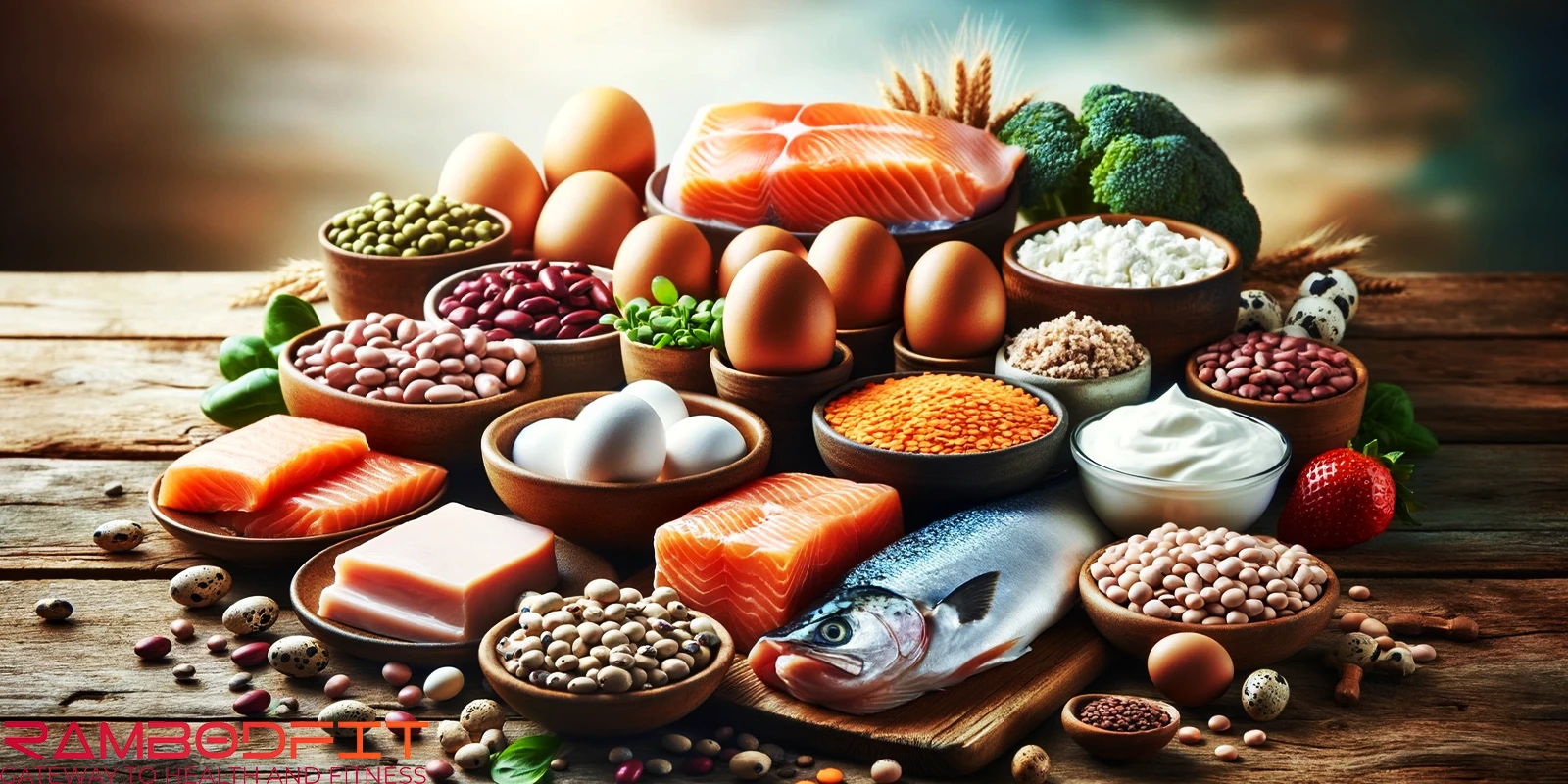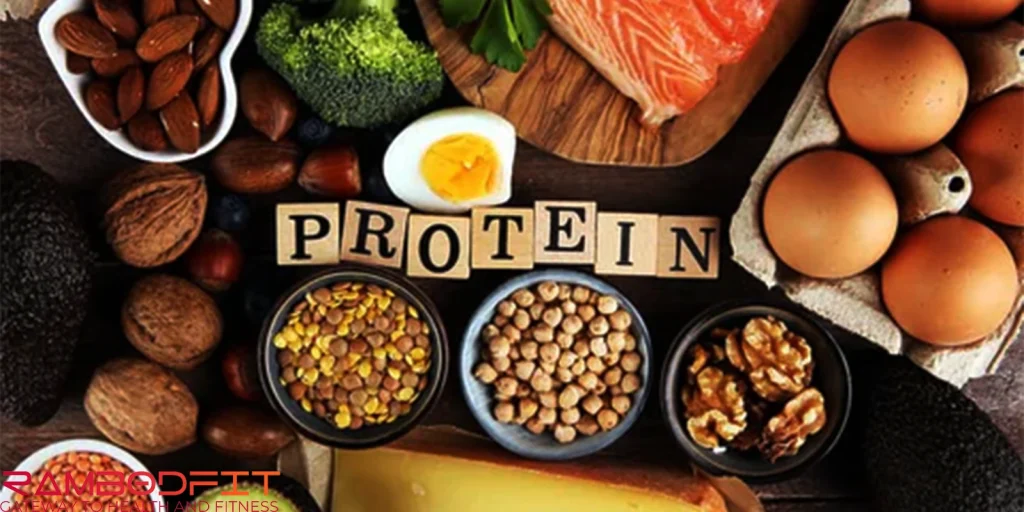


Have you ever stopped to picture what 50 grams of protein actually looks like on your plate? Whether you’re carefully counting your macros, working on building muscle, or just striving to make healthier food choices, reaching that 50-gram protein goal can be more challenging than it sounds. It’s easy to underestimate just how much food is required to hit that number, especially when you’re mixing different protein sources throughout the day.
For example, a couple of eggs at breakfast, a serving of chicken at lunch, or a handful of nuts as a snack all contribute to your total, but it takes some planning to make it add up to 50 grams. This 50 grams protein comparison helps you see how each source stacks up in real-life portions.
Understanding what this amount looks like in real food can help take the guesswork out of your meal prep. Rambodfit is here to break down the protein content of a variety of foods—ranging from animal-based options like chicken breast, fish, or lean beef, to plant-based choices such as beans, lentils, tofu, and nuts. Through this 50 grams protein comparison, we’ll show you what typical servings look like and how many calories come along for the ride, so you can be mindful not just of your protein intake but also your overall calorie consumption.
You might be surprised to learn that it takes about 7 ounces of cooked chicken breast or almost 2 cups of cooked lentils to get to 50 grams of protein. Meanwhile, if you’re relying on nuts or cheese, you’ll not only need to eat a larger quantity, but you’ll also be consuming more fat and calories. This 50 grams protein comparison makes it easier to visualize these portions so you can better balance your meals to fit your goals—whether that’s muscle gain, fat loss, or simply maintaining a healthy lifestyle.
So, let’s take a deeper dive into the world of protein. From portion sizes and calorie counts to the best combinations of foods for a complete amino acid profile, Rambodfit is here to guide you through what it really takes to reach that 50-gram milestone, one meal at a time. This 50 grams protein comparison will give you a clear, practical picture of how different foods contribute to your daily protein needs.
Table of Contents

Let’s break it down food by food with a 50 grams protein comparison. You might be surprised to see how dramatically protein density and calorie load vary between plant-based and animal-based sources. While both categories can provide sufficient protein, the ratio of protein to total calories often differs substantially. Plant-based options tend to deliver protein alongside additional nutrients such as fiber and complex carbohydrates, whereas animal-based options generally concentrate protein more densely within a smaller caloric range. This 50 grams protein comparison highlights how not all protein sources are nutritionally equivalent, and understanding their relative density can help you make more informed choices depending on your goals—whether you’re optimizing for efficiency, balance, or overall nutrient composition.
If you want 50 grams of protein from cashews, you’re looking at eating about 325 grams, or two big cups. That adds up to 1,866 calories—kind of wild, right? This 50 grams protein comparison shows that while cashews pack a punch when it comes to healthy fats and minerals, they’re not exactly the best bang for your buck if you’re chasing protein. I’ve been there myself. You think you’re just grabbing a quick snack, but those “harmless” handfuls can sneak a ton of calories into your day before you even notice.
To get 50 grams of protein from chickpeas, you’ll need around 3 cups of the cooked stuff—about 918 calories. This 50 grams protein comparison makes it clear that while chickpeas really shine when it comes to fiber and complex carbs, they’re not the leanest protein out there. Still, they’re perfect for vegetarian diets and bring a nice texture to salads and stews.
Lentils just make sense. To get 50 grams of protein, you only need about 205 grams of dry lentils, which cooks up to around 409 grams. That’s 722 calories, give or take. This 50 grams protein comparison shows that besides the protein, lentils pack a lot of iron and magnesium, plus those slow carbs that keep you going. I reach for them at lunchtime when I want something filling, high in protein, and still totally plant-based.
Here’s a great pick if you’re vegetarian. To get 50 grams of protein, just grab about 2 cups of cottage cheese—roughly 435 grams. You’re looking at only 441 calories for all that, which is pretty impressive. This 50 grams protein comparison shows that cottage cheese packs a lot of casein protein too, so it digests slowly and helps your muscles recover while you sleep.
Tempeh, a fermented soy product, gives you 50 grams of protein in around 245 grams, costing just 470 calories. It’s dense, flavorful, and packs probiotics too—making it a smart choice for both your gut and your gains.
This is where things start to make sense. To hit 50 grams of protein, you’re looking at around 8 whole eggs—that’s about 572 calories. This 50 grams protein comparison highlights how eggs pack a punch: complete protein, all the key amino acids, choline, and some good fats too. Honestly, I like to mix it up. I’ll go with 4 whole eggs and toss in 4 egg whites. That way, I keep the protein up but the calories don’t get out of hand.
Beef lovers, rejoice. 250 grams of cooked sirloin gives you 50 grams of protein and about 535 calories. This option delivers high biological value protein along with creatine, iron, and B vitamins—perfect for athletes who need both strength and recovery fuel.
Chicken breast is about as simple and efficient as it gets. You start with 220 grams raw—once it’s cooked, you’re left with 175 grams, packing in 50 grams of protein for just 264 calories. This 50 grams protein comparison makes it clear why chicken breast is hard to beat if you’re trying to shed fat and keep your muscle. There’s a reason you see it in nearly every fitness meal plan out there. It just works.
Surprisingly light yet protein-dense, 250 grams of raw (210 grams cooked) shrimp gives you 50 grams of protein with just 213 calories. This 50 grams protein comparison shows that shrimp is low in fat, high in iodine, and easy to digest. I often use shrimp as a quick dinner protein—it cooks in minutes and doesn’t leave you feeling heavy.
Here’s the thing: it’s not just about how much protein you’re getting, but how many calories come along for the ride. This 50 grams protein comparison shows that nuts and legumes have plenty of nutrients, but you’re also getting extra calories and carbs. If you look at chicken, shrimp, or cottage cheese, you get a lot more protein for fewer calories. So, what really matters is picking a protein source that lines up with what you want—maybe you’re after lean muscle, dropping a few pounds, or sticking to plant-based foods. Choose what fits your goal.
Reaching a daily target of 50 grams of protein looks different for everyone, largely because it depends on your personal food preferences and dietary choices. This 50 grams protein comparison shows that if you prefer plant-based sources like cashews, chickpeas, or lentils, you’ll find that these foods contain protein, but also come with higher amounts of carbohydrates and fats. As a result, you might need to consume larger servings—and therefore more calories—to reach your protein goal. This can be challenging if you’re watching your calorie intake or trying to feel full without overeating.
On the other hand, animal-based proteins such as lean meats, fish, eggs, and dairy products provide much more protein per serving. This 50 grams protein comparison makes it clear that these foods are more protein-dense, meaning you can reach your goal with smaller portions and fewer extra calories. For instance, a small chicken breast or a cup of Greek yogurt can quickly add a significant amount of protein to your daily total without much effort.
Ultimately, your path to 50 grams of protein will depend not just on the foods you choose, but also on your broader eating habits, health goals, and what you genuinely enjoy eating. This 50 grams protein comparison reinforces that if you’re an athlete or very active, you might prioritize high-protein foods to support muscle repair. If you’re vegetarian or vegan, you’ll need to be strategic, perhaps combining different plant-based proteins throughout the day to ensure you’re getting all the essential amino acids.
Mixing up your protein sources can also help prevent boredom and make your meals more satisfying. Through this 50 grams protein comparison, you can see how incorporating a variety of foods—beans and tofu, eggs, fish, nuts, or dairy—keeps things interesting and ensures you’re getting a range of nutrients along with your protein. The key is to find a balance that fits your lifestyle and preferences, so that meeting your protein needs feels easy and sustainable, rather than overwhelming. With a little planning and flexibility, hitting your protein target can become a natural and enjoyable part of your daily routine.
Further Studies
Not necessarily. While plant proteins sometimes lack certain amino acids, a varied diet (e.g., mixing lentils, beans, and grains) provides complete coverage. The key is diversity, not perfection in a single food.
Among these, shrimp and chicken breast top the list for lean, low-calorie, high-quality protein. Cottage cheese also stands out for those who prefer vegetarian options.
Combine different sources. For instance, 1 cup of cottage cheese (25g) + 3 eggs (18g) + a handful of lentils (7g) can easily meet your goal without overloading calories.